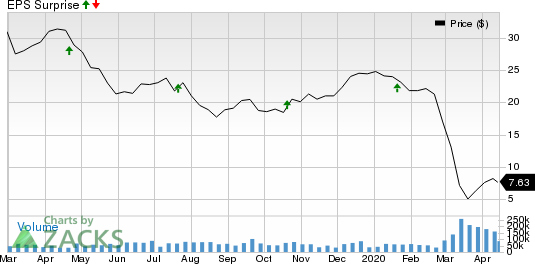Factors Likely to Influence Halliburton (HAL) in Q1 Earnings
Halliburton Company HAL is set to release first-quarter 2020 results before the opening bell on Monday, Apr 20. The current Zacks Consensus Estimate for the to-be-reported quarter is a profit of 25 cents per share on revenues of $5.1 billion.
Let’s delve into the factors that might have influenced the company’s performance in the March quarter. But it’s worth taking a look at Halliburton’s previous quarter performance first.
Highlights of Q4 Earnings & Surprise History
In the last reported quarter, the major oilfield service provider beat the consensus mark on robust international activity. Halliburton reported earnings per share of 32 cents that surpassed the Zacks Consensus Estimate by 3 cents. However, the bottom line was lower than the year-ago figure of 41 cents due to headwinds in North America. Meanwhile, revenues of $5.2 billion were 12.6% lower than the year-ago quarter but topped the Zacks Consensus Estimate of $5.1 billion.
As far as earnings surprises are concerned, the world's second-largest oilfield services company after Schlumberger SLB is on a solid footing, having gone past the Zacks Consensus Estimate in two of the last four reports, with the average positive surprise being 6.75%. This is depicted in the graph below:
Halliburton Company Price and EPS Surprise

Halliburton Company price-eps-surprise | Halliburton Company Quote
Factors to Consider
Halliburton’s North America operation — which represents more than 50% of the company’s revenues — is likely to have dragged down the company’s performance in first-quarter 2020.
Let’s analyze:
E&P Capital Spending Slump: Even before the oil price slump, clients had been taking a conservative approach on their investment decisions. Consequently, major upstream oil companies were committed to investor returns rather than adding production by outspending cash flows. This created an extremely challenging operating environment for the service providers. With crude prices crashing during the three-month period ending Mar 31, things took a turn for the worse.
In fact, the commodity ended the quarter at just over $20 a barrel, which is certainly not enough to trigger investments in mature field development, exploring unconventional resources, or expanding offshore programs. This slowdown in activity is likely to have hurt demand for Halliburton’s services and equipment in the first quarter. As a result, the company’s first-quarter operating income from the Completion & Production segment – the main contributor to Halliburton earnings – is pegged at $344 million. The segment had recorded operating income of $368 million in the corresponding period of 2019.
Steep Drop in North American Rig Count: During the first quarter of 2020, U.S. rig count decreased by 77 sequentially (from 805 to 728) in conjunction with the oil price crash. While there is a typical delay of around three-four months between oil price changes and its reflection on rig counts, the statistics suggest faltering North American drilling and completion activity in the January-March timeframe. Halliburton, with sizable presence in the region, is expected to have suffered heavily on this sentiment.
International Markets Offer Some Hope: One bright spot in the otherwise gloomy earnings outlook is the solidity in overseas markets. Halliburton's international revenues increased 10% year over year in the fourth quarter of 2019, a trend that most likely continued in the first quarter as well.
While international E&Ps are also pulling back on spending due to continued weak oil prices, the degree of decline is likely to have been less than North America. This is because most of these projects are backed by national oil companies and/or integrated majors that consider a long-term horizon. Moreover, a sizable proportion of international projects are offshore that have been okayed over the past few years and are difficult to stop or cancel suddenly.
What Does Our Model Say?
The proven Zacks model does not conclusively predict an earnings beat for Halliburton this time around. The combination of a positive Earnings ESP and a Zacks Rank #1 (Strong Buy), 2 (Buy) or 3 (Hold) increases the chances of an earnings beat. But that’s not the case here.
You can uncover the best stocks to buy or sell before they’re reported with our Earnings ESP Filter.
Earnings ESP: Earnings ESP, which represents the difference between the Most Accurate Estimate and the Zacks Consensus Estimate, for this company stands at -2.00%.
Zacks Rank: Halliburton has a Zacks Rank of 3.
Stocks to Consider
While earnings beat looks uncertain for Halliburton, here are some firms from the energy space you may want to consider on the basis of our model, which shows that they have the right combination of elements to post earnings beat this season:
Murphy USA Inc. MUSA has an Earnings ESP of +44.49% and a Zacks Rank #2. The company is scheduled to release earnings on Apr 17.
You can see the complete list of today’s Zacks #1 Rank stocks here.
Laredo Petroleum, Inc. LPI has an Earnings ESP of +3.16% and is Zacks #3 Ranked. The firm is scheduled to release earnings on May 6.
Today's Best Stocks from Zacks
Would you like to see the updated picks from our best market-beating strategies? From 2017 through 2019, while the S&P 500 gained and impressive +53.6%, five of our strategies returned +65.8%, +97.1%, +118.0%, +175.7% and even +186.7%.
This outperformance has not just been a recent phenomenon. From 2000 – 2019, while the S&P averaged +6.0% per year, our top strategies averaged up to +54.7% per year.
See their latest picks free >>
Want the latest recommendations from Zacks Investment Research? Today, you can download 7 Best Stocks for the Next 30 Days. Click to get this free report
Schlumberger Limited (SLB) : Free Stock Analysis Report
Halliburton Company (HAL) : Free Stock Analysis Report
Murphy USA Inc. (MUSA) : Free Stock Analysis Report
Laredo Petroleum, Inc. (LPI) : Free Stock Analysis Report
To read this article on Zacks.com click here.
Zacks Investment Research
